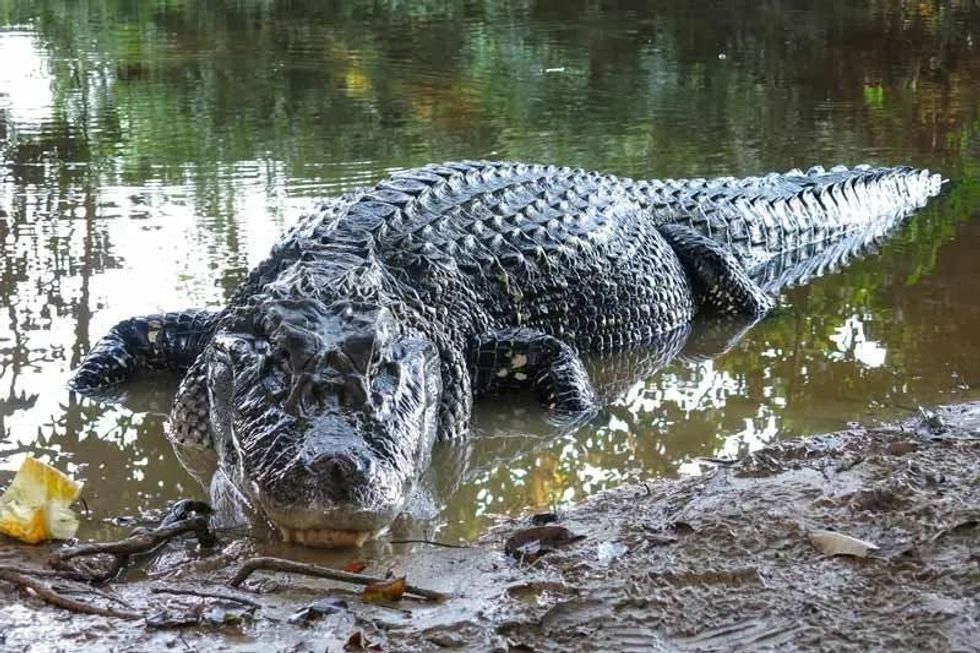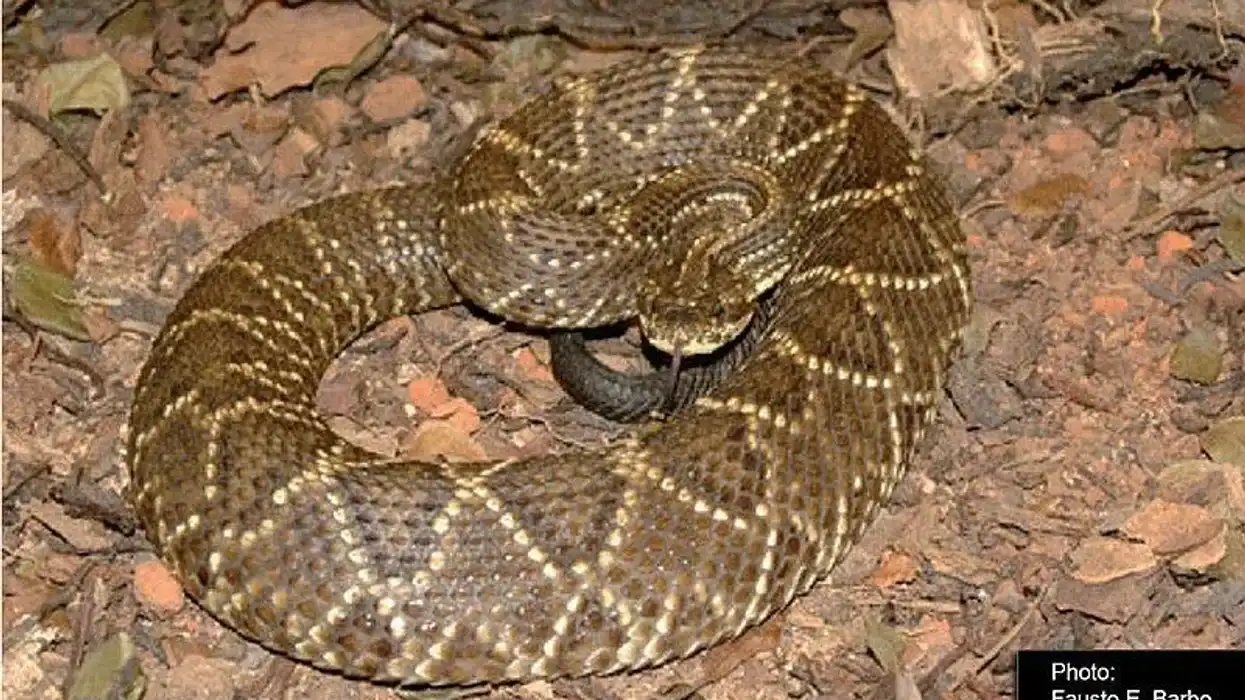Among the world's most famous predators, a Black Caiman is an animal that has earned the tag of the largest predator of the Amazon. Black Caimans are widely found throughout Bolivia, Brazil, Colombia, French Guiana, and Peru. It is the apex predator in the Amazon. The preferred habitat of this animal is the shallow ponds and slow moving rivers.
They predominantly prey on fishes, and other mammals, including sloths, deer, and buffaloes. Although very often confused with crocodiles and alligators, a Caiman is distinctly different from the two. They belong to the same class but are from different families. Alligators and Caimans are much more closely related, but they have different habitats.
Black Caimans are not very aggressive to their family members. But they are incredibly hostile in the mating season when the eggs are laid by the females.
These animals are highly feared for being one of the topmost predators of the Amazon jungles. Even other dangerous predators like a jaguar or a cougar would avoid those areas inhabited by a Black Caiman.
If you find this article fascinating, you may also check out the fact files on green anaconda and lava lizard from Kidadl.
Black Caiman Interesting Facts
What type of animal is a Black Caiman?
A Black Caiman is a type of caiman crocodilus. It is a crocodile species, which has distinct dark-colored skin.
What class of animal does a Black Caiman belong to?
Black Caiman (Melanosuchus niger) is an animal that belongs to the class of Reptilia. These species belong to the family Alligatoridae.
How many Black Caimans are there in the world?
The total estimated population of Caiman species is approximately eight million.
Where does a Black Caiman live?
Black Caimans can be most commonly found in lakes and rivers. Rivers that are slow moving are their most favorite spot. But, Black Caimans are aquatic reptiles, which means they can also be found in flooded areas.
What is a Black Caiman's habitat?
The Amazon basin in South America has numerous rivers which are slow moving. These are the preferred habitat of this species of crocodiles.
The Amazon River, spreading across the countries like Bolivia, Brazil, Colombia, is the most occupied habitat of every Caiman species. But the Black Caiman is the largest one occupying these rivers. They are found in countries like French Guiana, Ecuador, Peru as well.
Who do Black Caimans live with?
Black Caimans are usually found to be living by themselves. They are solitary in nature most of the time. But in the seasons for mating, they are found to be gathering in groups. These groups are called pods, which a female black Caiman guards.
How long does a Black Caiman live?
The average lifespan of a Black Caiman ranges from 13 years to as long as 80 years.
How do they reproduce?
The months of September through December, which is the dry season, is the nest-building season of a female Black Caiman. Like all other alligators and crocodile species, Black Caimans are polygamous. Females lay as many as 65 eggs in one season.
These eggs start to hatch in the wet season. Although this season provides safety, not all babies survive till adulthood. The water level drops throughout the entire dry season, which forms a very rich food source in the mating season.
What is their conservation status?
According to the IUCN Red list, the Black Caiman species is listed as 'Conservation Dependent. In the 1970s, the red list had tagged this species as Endangered.
The illegal hunting and trading of Black Caimans and habitat destruction had led to such a condition. This situation has turned better now to some extent as there are much more efforts taken to protect it.
Black Caiman Fun Facts
What do Black Caimans look like?
Black Caiman (Melanosuchus niger) belongs to the crocodile species, which is unique due to its darkly colored skin. You can find this predator in the Amazon basin, beautifully camouflaged due to its skin.
This largest predator of the Amazon has light yellow patches throughout its body. It has large and protruding brown eyes. The snout of this species is comparatively smaller.
How cute are they?
Black Caimans are not very cute to look at. These animals are very dangerous and are rightly termed, apex predators.
How do they communicate?
Not much can be said about communication between Black Caimans. But much like other crocodile species or alligators, Black Caimans of the amazon river make noises to communicate among them. These noises are pretty similar to the rumbling thunder.
How big is a Black Caiman?
The length of a Black Caiman is between 200-400 cm (79-157 in). This makes them of the same size as an American Alligator and at least five times larger than a Red fox.
How fast can a Black Caiman move?
A Black Caiman can move at the speed of 48 kph (30 mph). This makes them at least two times faster than a saltwater crocodile and four times faster than alligators on land.
How much does a Black Caiman weigh?
The average weight of a Black Caiman is between the range of 300-400 kg (661-882 lb). This makes them two times heavier than an American Alligator.
What are their male and female names of the species?
A male adult Black Caiman is named bull. The female adult Black Caiman is called a cow.
What would you call a baby Black Caiman?
A baby of a Black Caiman hatches from eggs. They are called hatchling.
What do they eat?
A Black Caiman is one of the most well-known carnivorous animals. The primary prey of this species is fish, especially the piranha, or catfish.
But adult Black Caimans are often found to be feeding on larger prey, like deer, dogs, capybara, and so on. These predators have immense bite force, which they use to trap various mammals and even birds. Among the mammalian prey, there are coatis, sloths, and even armadillos that these predators feed upon.
Are they poisonous?
No, Black Caimans are not at all poisonous. These animals are rather dangerous due to their immense bite force with which they attack their prey.
Would they make a good pet?
No, these animals should never be kept as pets. They are extremely dangerous and can attack if provoked.
Did you know...
A unique fact about Black Caiman is that they are not crocodiles or alligators. These predators of Amazon are often mistaken as crocodiles or alligators. They belong to the same order, but their families are different.
You can easily differentiate between a crocodile and a caiman. The snout of a caiman is rounded, with a distinct U shape. But the snout of a crocodile is V-shaped and is sharper.
Owning to the fact that the bodies of these animals are covered with black scales, they are named Black Caiman. This predator spends most of its time in the waters of the Amazon river basin. Another essential fact about Black Caimans is that they faced extinction from the 1950s to 1970s.
Black Caiman size comparison
Black Caimans can grow to giant sizes. If compared to a saltwater crocodile, then a Black Caiman will be of almost half the size.
A Black Caiman can be smaller by nearly a meter or two if compared to a Komodo Dragon. It can be differentiated from a spectacled Caiman owning to its large head and jaw color. These animals can be three to four times larger than a West African Dwarf Crocodile.
Black Caiman dangerous facts
A Black Caiman is known to be an apex predator. They are always at the top of a food chain. Although they are not considered to be particularly dangerous to humans, they will attack if you provoke them.
Like jaguar or cougar, other top predators seem to avoid those habitats claimed by a Black Caiman. There are a few instances where a Black Caiman has overpowered a jaguar. These predators have tremendous bite force, which is their primary strength.
Here at Kidadl, we have carefully created lots of interesting family-friendly animal facts for everyone to discover! Learn more about some other reptiles including sand lizard, or gila monster.
You can even occupy yourself at home by drawing one on our Black Caiman coloring pages.










